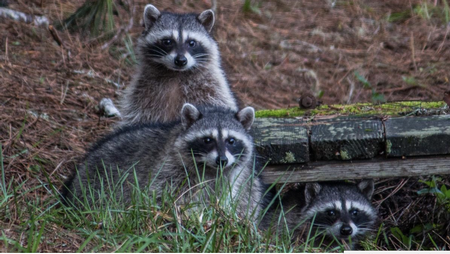Raccoons: Cute, But Not When They're Busting into Your Attic

ABOUT
- Recognizable: dark grayish brown fur interspersed with tan accents, black facial mask surrounded by white, big furry tails with light and dark rings.
- Native to North and Central America.
- 2 to 3 feet long and 7 to 30 pounds in weight.
Behavior
- Cute, clever, intelligent, dexterous.
- Can easily manipulate objects with their front paws.
- Can become vicious when cornered.
- Excellent night vision.
- Habit of washing their food, called "dousing."
- Communicate using a variety of sounds including purring, growling, hissing, and whistling.
Food
- Both plants and animals (omnivores), including berries, nuts, acorns, corn, pet food, birdseed, clams, fish, snails, insects.
- Chickens and chicken eggs are especially attractive food sources.
Predators
- Coyotes, wolves, and fox are the primary predators.
- Also: large dogs, bobcats, mountain lions, owls, and eagles.
- In areas where there are few natural predators, raccoons commonly die from interaction with humans and automobiles.
Diseases
- Fleas and ticks. These parasites can infest attics and migrate to other parts of the home once a nesting site is established.
- Rabies and distemper. (Be sure pets are properly vaccinated.)
SIGNS
- Evidence of feeding, tracks, and droppings.
- Noises on roof, in the chimney, or in the attic.
Nesting
- Ripped off roof shingles, fascia boards, and roof ventilators to gain access to attic.
- Destroyed crawl space doors or screens to get under the house.
- Torn up insulation, heating, and air conditioning ducts.
- Unpleasant odor and stains on wood and sheetrock when nesting site is used as a latrine.
Eating
- Destroyed vegetable gardens. (Sweet corn is particularly desirable right before harvest.)
- Rolled up turf and destroyed lawns when looking for worms and grubs.
- Missing koi and goldfish from backyard ponds. (Raccoons will not dive for food. Ponds over two feet deep with steep sides and aquatic plants provide shelter for fish.)
WHERE
- Urban and suburban raccoon populations can become quite large.
- Prefer wooded areas near water, live in dens in hollow trees, ground burrows, brush piles, or rock crevices.
WHEN
- Active all year in mild climates.
- Nocturnal, but often seen during the day, especially when raising a litter.
- Litters born in the spring, typically two to six babies called kits.
- Families stay together for a year.
- Because raccoons are active mainly at night, they can go undetected for some time.
PREVENT
Habitat modification
- Use metal trash cans with secure lids for garbage and storage of any potential food source such as birdseed.
- Place trash cans in a rack or tie them to a secure post to prevent raccoons from tipping them over.
- Use a bungee cord or wire to secure lids.
- Remove any pet food and pet dishes left outdoors before nightfall.
- Secure pet chickens before sundown.
- Pick up fallen fruits and nuts frequently.
- Never intentionally provide food for raccoons.
- Remove woodpiles or other possible nesting materials.
- Thin out overgrown shrubbery to reduce cover.
- Trim back tree branches overhanging rooftops; if possible, leave at least a five-foot gap between the roof and the tree.
- Relocate trellises and arbors attached to your home to limit access to your roof.
MANAGE
Exclusion
Chimneys: Cover with spark arrester that meets your local fire code. Attach chimney caps to prevent raccoons from pulling them loose. Be sure there are no animals in your chimney before covering the opening. If raccoons have already started to nest in your chimney, hire a professional to remove them.
Screening: Tightly screen all open spaces beneath structures, such as porches, decks, garden and tool sheds, with 10-gauge 1/4- or 1/3-inch galvanized hardware mesh. Bury the bottom edge of the wire at least six inches deep, extend outward for 12 inches, and then back-cover with soil. (These measures also help exclude skunks, opossums, squirrels, and rats.)
Fencing: Ordinary fencing does not keep raccoons from entering your garden because they will either dig under or climb over them. Raccoons locate weaknesses in fences and will rip off loose boards or enlarge holes in wire fences for easy access. Electrified fences may be effective. Consult a professional.
Trapping
California Department of Fish and Game Regulations prohibit the relocation of raccoons and other wildlife without written permission of the Department. Contact a professional wildlife control officer.
